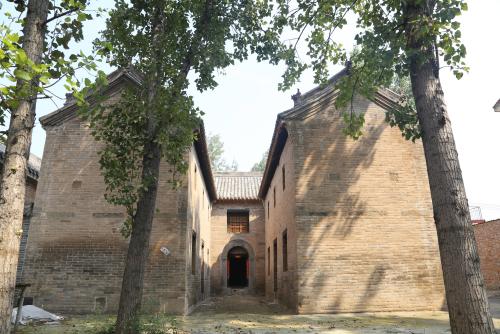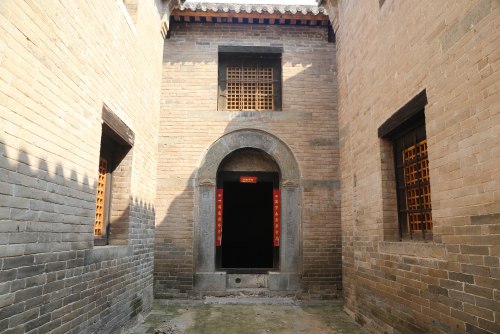The villages on the Huaichuan Plain look similar, but they are different. Many annihilated historical sites, dusty memories, long legends and fragmentary oral history of the rural seniors are all dim or brilliant living fossils in the long history of the countryside.
Ye Tianshi, a medical scientist in the Qing Dynasty and one of the "four masters of febrile diseases", whose real name is Ye Gui, alias Ye Tianshi, has been handed down from generation to generation, such as "warm Heat Theory", "Clinical Guide Medical Records" and "Ye Tianshi Medical Records". He was the first medical scientist to discover scarlet fever in China, pioneered the syndrome differentiation outline of "Wei, Qi, Ying and Blood" for the treatment of febrile diseases, and was regarded as the founder of the school of febrile diseases. According to legend, in his later years, Ye Tianshi went to practice medicine in rivers and lakes and treated many villagers when he passed through Gangtou Village. After the villagers struggled to stay, Ye Tianshi settled down to practice medicine by a large mulberry tree in the west of Gangtou Village, hung a pot to save the world, and was called "King of Sangzhuang" and "Sangzhuang Hu Medical Immortal". In the eleventh year of Jiaqing in the Qing Dynasty, the villagers built Xiansheng Temple (commonly known as Sangzhuang Temple) to commemorate it.In the middle of the Ming Dynasty (1368-1644), there were several families surnamed Wang who moved to Hongdong County, Shanxi Province on the east bank of Jianggou (now known as the Grain River). When Li Zicheng, the leader of the peasant uprising in the late Ming Dynasty, was stationed here, he found that the topography of the village was similar to that of Guantou, so he named it. Then there are the people of Zhao, who moved from Qunxia Village to Gangtou Village, Hongdong County, Shanxi Province, where they lived.The Zhao surname of Gangtou Village, who attached great importance to ploughing and reading, specially hired a teacher from the Confucius Temple in Qufu, Shandong Province to teach here, and many children were able to stand out as sons of man and honor their ancestors, so they advocated the construction of a temple of noble sons, hoping for more noble children. The main beam of the temple is said to be "East Bauhinia and West Jujube" with sturdy bauhinia trees and sour jujube trees as beams.According to legend, the reception hall built by Zhao's ancestors during the reign of Qianlong could entertain thousands of guests and run the four carriages in circles. When the fourth brothers Zhao Dexiang and Zhao Xirui separated, they were each divided into two mansions, two hundred meters long from north to south and tens of meters wide from east to west. Zhao Dazhen, the sixth grandson, made a career of leasing land and selling grain. Often dressed in rags, he went to various market towns to inquire about the market and buy grain. At first, he pretended that he could not afford it. When he infuriated the grain sellers to hold down the price to the lowest level, he showed his big treasures and bought them all. He hired Sun Xingrong in Tao Village as a bodyguard and trafficked grain to Shandong. He passed through an octagonal pavilion and was blackmailed by gangsters. With a move of "pulling onions from dry land", the gangster jumped up and put Sun Xingrong's clothes on the beam at the top of the pavilion. Sun Xingrong did not show weakness, holding the post in his arm, and "pulling out the weeping willow" put enough clothes under the pillar.Because of the chaos of war, when Gai spread to Zhao Wantian, the son of Zhao Dazhen, his family was in a state of decline. At present, only three two-story hard mountain ash tube tile attic buildings built in the seventh year of Daoguang of the Qing Dynasty (now owned by Zhao Songping, a descendant of Zhao). The main room has a wide face and a deep one, and there is a stone arch coupon door cover on the first floor, which is engraved with the couplet of "Brother Yidi under the Bauhinia, Neutron in the Caiwu Hall", and the forehead plaque of "harmony and auspiciousness" is hung on it. There are patterns of bluestone relief, Phoenix and unicorn on the lintel. Bluestone carvings on both sides of Banmen are decorated with lotus flowers and auspicious Sibao flowers. The east-west wing room has three wide rooms, a deep one, a two-story double-slope hard hilltop, a beam-lifting frame and an ash tube tile roof.In 1945, General Huang Xinyou, commander of the eighth military region of our Taihang military region, led his department to recover more than 40 enemy and puppet strongholds in Xiaodong, Ningguo, and other places, and opened up anti-Japanese guerrilla base areas in Xiuwu County. Commander Huang Xinyou directed the battle in the main room of the Zhao mansion in Gangtou, leaving many stories.


